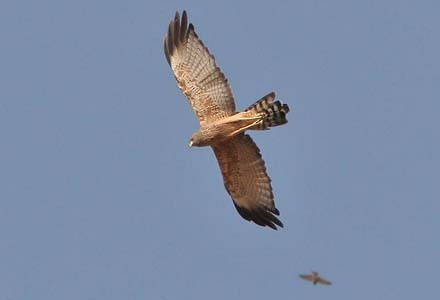Spotted Harrier
A species of Harriers Scientific name : Circus assimilis Genus : Harriers
Spotted Harrier, A species of Harriers
Botanical name: Circus assimilis
Genus: Harriers
Content
Description General Info
 Photo By Don Roberson
Photo By Don Roberson Description
The spotted harrier is a medium-sized, slender bird of prey with adult females reaching 58–61 cm. Both adults and juvenile birds have an owl-like facial ruff that creates the appearance of a short, broad head as well as long yellow legs. The spotted harrier's wings feature prominent black tips and the tail is prominently barred and slightly wedge shaped. Adult males are much smaller than the females only growing to 50–55 cm. Adult birds have blue to grey upper parts with a chestnut face and underparts that feature numerous white spots. Juvenile birds in their first year of life are mostly a dark brown and buff on their upperparts with pale buff underparts that feature brown streaks across the chest and stomach. During the second year of their life the spotted harrier takes on almost adult colouring with white streaks across their underparts instead of the prominent spots that can be seen on adults. 
Size
61 cm
Nest Placement
Ground
Feeding Habits
Spotted Harrier primarily consumes terrestrial mammals, small birds, reptiles, and large insects. Adaptive to prey decline, spotted Harrier shifts from rabbits to native species, despite habitat threats. It exhibits distinctive soaring with elevated wings during hunting.
Habitat
The spotted Harrier principally inhabits open environments such as treeless grasslands, sparse woodlands, subdeserts with thornbush, savannas, and agricultural plains, with a predilection for wheat fields. While they nest within woodlands, they are generally not found in wetland areas, although they do hunt over coastal flats and ricefields.
Dite type
Carnivorous
General Info
Feeding Habits
Bird food type
Distribution Area
The spotted harrier is native to Australia and Indonesia, however vagrant populations have been seen in Timor-Leste. It has a geographic range of more than 20,000km2 (Birdlife International, 2012). Spotted harriers can be seen throughout most of Australia's mainland, except in densely forested or woodland habitats of the coast, escarpments and ranges, and rarely in Tasmania. In NSW individuals are widely dispersed, comprising a single population. The spotted harrier is a terrestrial bird residing in open grasslands, open woodland including acacia and mallee, inland riparian woodland, grassland and shrubland. It can be most commonly found in native grassland however it is also seen in agricultural land and inland wetlands for the purpose of foraging. 
Species Status
Due to its extremely large range, and its large and stable population, the spotted harrier has been designated as a species of least concern by the International Union for the Conservation of Nature. The species was included in a NSW population survey in 1977-81 which used 75 one degree grids to find bird population numbers. The spotted harrier recorded at mostly moderate to high reporting rates (11-40% and more than 40% of surveys per grid, respectively). Breeding was recorded in 14 of these grids. A repeat of this survey was performed in 1998-2002 which found that spotted harrier numbers had declined (less than 20% of surveys per grid), with breeding in only 6 grids. This suggests that a statewide decline of 70% over 3 generations (30 years) will occur. One issue with this study is that due to the large distribution of the spotted harrier this study only covers a small sample of the entire species, misrepresenting the species as a whole. Also it is known that there are many threatening processes occurring in NSW that are affecting populations on a large scale basis that are not happening as prolifically in other areas. This study should be performed through the whole distribution of the species to find and accurate summary of the species population status. This study does however accurately represent populations in NSW and therefore a management plan can be put in place to manage numbers in this state alone. 

 Photo By Don Roberson
Photo By Don Roberson